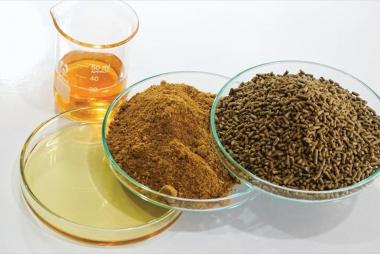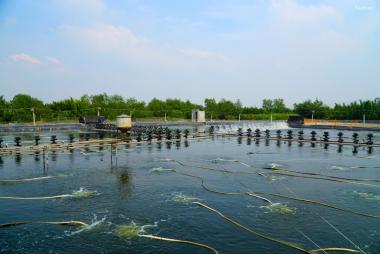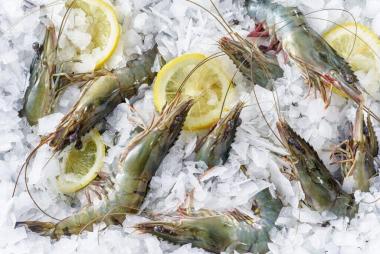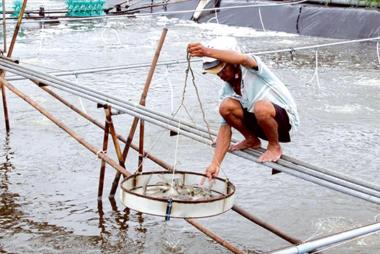- Address: Lot No. 20, Zone G, D1 Street, An Ha Industrial Park, Tan Vinh Loc Commune, Ho Chi Minh City
- Phone: (84-28) 668.36156 / 668.36158
- Hotline: 1800.9435
- Fax: (84-28) 3620.4694
- Email: vibo@vibo.com.vn
- Website https://vibo.com.vn/

Advances in Vaccines in the prevention of Vibrio spp. on fish

Use of vaccines to prevent diseases on pangasius.
Advances in Vaccine Development to Prevent Vibrio spp. on fish offers hope to quell many major diseases.
With the continuous development of the aquaculture industry, the output of fish, shrimp, crab, mollusks, and other aquatic animals reaches nearly 200 million tons/year. However, pathogens and external factors such as water quality, farming practices, and environmental degradation have resulted in an increasingly complex disease problem.
Among them, Vibrio spp. belongs to the family Vibrionaceae that can grow and survive independently in the water environment. There are two main modes of infection. The bacteria first attach to the surface of the host and then infect by penetrating the skin. When the lining is damaged, the risk of infection increases. The second type is an oral infection caused by food or water contaminated with pathogenic bacteria.
Therefore, there is an urgent need to control Vibrio spp. There are many biological approaches to disease prevention and control in aquaculture that are being studied and showing promising results. The vaccine is an outstanding, highly effective, safe, and convenient method that demonstrates superior immunity protection and has strong long-term stability making it the most suitable method. to control fish disease. This review provides a research progression of Vibrio spp. Vaccines, including inactivated vaccines, live-attenuated vaccines, subunit vaccines, DNA vaccines, ...
Inactivated vaccine
During the past two decades, the study of vaccines against Vibrio spp. on fish has made great progress. Conventional vaccines are produced by pathogenic microorganisms and their metabolites through attenuation or inactivation mainly including inactivated and attenuated live vaccines used to vaccinate fish. by injection through the peritoneum. These vaccines have been used successfully for the prevention and control of Vibriosis.
Inactivated vaccines are intact infectious bacteria or viruses that are destroyed either physically or chemically after amplification and culture, rendering them pathogenic and retaining antigens. The inactivated vaccine is characterized by safe-use, easy storage, and no risk of inducing a humoral immune response. A formalin-inactivated vaccine has been shown to provide good protection against orange spot grouper against Vibrio harveyi infection. Another study suggested that vaccinated tilapia exhibited a protection rate (RPS) of 88% following exposure to Vibrio vulnificus.
Live vaccine
However, compared with the attenuated live vaccine, the inactivated vaccine uses antigens that are unable to multiply. Therefore, inactivated vaccines often require multiple injections, large vaccination doses, and short and single vaccination times. Consequently, adjuvants are often required to enhance the immunogenetic properties of these inactivated vaccines. However, there are many serious side effects. These shortcomings spurred the development of a generation of excipients including nano, microparticles, aluminum-containing excipients, β -Glucans, oligosaccharide chitosan, saponin, lipopeptides ...
Compared with inactivated vaccines, the attenuated live vaccines show superiority by multiplying in the host so that the body's immune response can trigger long-term protection. Different therapies should be used to reduce the toxicity of the pathogen and at the same time be able to preserve the immunogenicity. The number, nature, and location of the antigen are similar to that of a natural infection, so immunogenicity is generally strong. There is also a potential risk, however, that live vaccines can lead to infection in animals with poor immunity and the virulence reversible mutation. Analysis of experimental data showed that the Vibrio anguillarum vaccine significantly increased the protection rate (RPS) of the vaccinated flounder from 39.4% to 100% by removing the two genes alr1 and alr2 compared with inactivation with formalin only. In addition, the researchers used the increased concentration method of rifampicin to selectively reduce virulent Vibrio harveyi-T4DM strains that could induce protective immunity against Vibrio harveyi and Vibrio alginolyticus. However, the issue of sufficient degradation of strains must be ensured before these attenuated live strains are allowed to be widely used in aquaculture. Because traditional inactivated vaccines and live-attenuated vaccines have a limited role in controlling Vibrio infections. spp on a large scale. Subunit vaccines, DNA vaccines, and live vector vaccines are all very promising strategies.
Subunit vaccine
Subunit vaccines are known from extracting or synthesizing specific bacterial protein structures, that is, vaccines made from epitope (structural sites on an antigen molecule can react with a pattern of the chemical structure of antibody molecules or receptor molecules in blood or on immune cells).
Only a few major surface proteins are selected in the vaccine so that it can eliminate many of the adverse reactions caused by the unrelated epithelium. After cloning, sequencing the lamB gene, and performing biological information analysis on 8 different Vibrio strains showed that the lamB vaccine results could protect zebrafish against four different Vibrio types. To increase the protective efficacy of the subunit vaccine, the researchers combined different antigens.
DNA vaccine and live vector vaccine
The DNA vaccine introduces a plasmid containing the DNA sequence that encodes the antigen (which induces the desired immune response) directly into a suitable tissue, after which the immune response to the antigen is expressed after the host cell. receive. This vaccine has both the advantages of a live-attenuating vaccine and does not present the risk of virulence recovery.
Compared with subunit vaccines, DNA vaccines are more stable. The plasmid itself can be used as an adjuvant, cost-effective and convenient to use. Currently, however, DNA vaccines are primarily used by injection, but are clearly not practical for large-scale applications. The main goal is to design a vaccine that can not be injected that can be used by adding to feed, spraying, soaking, and characterized by a rate of protection, no residue and no contamination. Develop a DNA transport system, for example, to prevent plasmid DNA from being broken down in the digestive tract. Currently, a number of studies have successfully used chitosan nanoparticles as transport vectors for the Vibrio anguillarum DNA vaccine via feed supplementation.
Using biotechnology to target effective antigens in combination with new supplements to develop immersion Vibrio spp vaccines or oral supplementation could be a good way to control infections. This will not only satisfy consumers' demand for quality seafood products but also ensure a sustainable aquaculture environment.
A review: progress in the development of fish Vibrio spp. vaccines by author Q, Wang S, Ma J, Liu Q, Immunology Letters (2020)
Nguồn: tepbac.com














